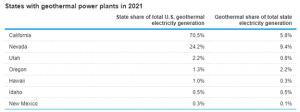CURRENT PROJECTS
In 2021, there were geothermal power plants in seven U.S. states (California, Nevada, Utah, Oregon, Hawaii, Idaho, New Mexico), producing about 16 billion kWh, equal to 0.4% of total U.S. utility-scale electricity generation.[1] Existing and planned U.S. geothermal installed capacity (MWe) by state is available here.

Source: U.S. Energy Information Administration[2]
U.S. Geothermal Power Market
The U.S. Electricity Information Administration (EIA) projects slow growth for geothermal development in its Annual Energy Outlook 2022.[3] The Annual Energy Outlook 2022 provides modelled projections of domestic energy markets through 2050, and includes cases with different assumptions of macroeconomic growth, world oil prices, technological progress, and energy policies. In these projections, geothermal energy does not play a big role as a source of electricity generation, as compared to other sources of renewable energy, and lesser still as compared to natural gas, nuclear, and coal sources.
However, the Geothermal Technologies Office Multi-Year Plan (FY2022-2026) indicates that geothermal deployment can grow to provide 60+ gigawatts-electric (GWe) of firm, flexible clean energy by 2050, with a major expansion of geothermal power production in and outside the western half of the U.S., where commercial geothermal power plants currently are concentrated. Geothermal electric power generation could increase nearly 26-fold through technology improvements that focus on exploring, discovering, developing, and managing geothermal resources.[4]
Current Geothermal Technologies Office (GTO)-funded Projects
Frontier Observatory for Research in Geothermal Energy (FORGE): GTO’s largest funded initiative, the Frontier Observatory for Research in Geothermal Energy (FORGE) program is a dedicated site and innovation hub in Utah where enhanced geothermal system (EGS) technologies and techniques can be developed, tested, and improved in an ideal EGS environment.[5] The Utah FORGE is an international field laboratory led by the University of Utah and managed by a team of engineers and scientists from universities, national labs, federal and state funded institutions, and private industry. [6] Learn more.
FORGE provides an underground laboratory for developing and testing new tools and stimulation techniques for developing EGS reservoirs. The Utah FORGE team started drilling its first highly deviated geothermal deep well (Well 16A(78)-32) in 2020, which was completed in February 2021. Also in February 2021, the Utah FORGE Program chose 17 projects in five topics in response to the 2020-1 FORGE Solicitation, the program’s first formal call for research proposals on EGS technologies. Selectees will receive a combined total of up to $49 million over the next three years.[7] In April 2022, the Utah FORGE team successfully completed a three-stage hydraulic stimulation of Well 16A(78)-32.[8]
Current R&D is focused on developing alternative completion techniques, adoption of relevant unconventional oil & gas stimulation methods, and identifying links between completion techniques and reservoir development and operation.[9] Upcoming activities will focus on locating the most promising fractures, and using the micro-seismic data collected during the stimulation to target and plan the location of the producer well, expected to be drilled in early 2023.[10] Learn about future FORGE solicitations and research news here and here.
GeoDAWN: An interagency partnership, the Geoscience Data Acquisition for Western Nevada (GeoDAWN) unites DOE’s Geothermal Technologies Office (GTO), the Department of the Interior’s Bureau of Land Management (BLM), and the US Geological Survey’s Earth Mapping Resource Initiative and 3D Elevation Program to collect information on undiscovered geothermal, critical mineral, and groundwater resources in the Great Basin and Walker Lane region. Recent discoveries have indicated significant potential for geothermal resources in western Nevada. This survey will collect information that will highlight which areas to focus on next.[11]
Play Fairway Analysis (PFA): This project utilizes advanced data-mapping techniques to identify favorable intersections of heat, permeability, and fluid in prospective areas of undiscovered hydrothermal resources. Subsurface permeability can be better understood by developing and confirming a model that connects geophysics, hydro-geochemical data, and geologic data along with mapping permeable paths in the subsurface. Through continued support to PFA, GTO will test and validate multi-physics inversion methods, 3D modeling techniques, machine learning approaches, and conceptual modeling through field-demonstration well targeting.[12]
Wells of Opportunity (WOO) – This project encompasses two topic areas: 1) Amplify – EGS Near-Field RDD&D; and 2) ReAmplify – Geothermal production from hydrocarbon wells. The goal of Amplify is to illustrate that near-field and in-field EGS can now be successfully deployed due to recent technology advancements, and that low permeability/underproductive wells near and in existing hydrothermal fields can be turned into valuable assets using EGS techniques. Additional near-field EGS demonstrations are being initiated, including a focus on shallow heat located near existing hydrothermal fields. The goal of ReAmplify is to establish a pilot program where the production of geothermal heat from existing hydrocarbon fields can be demonstrated for electricity production, or direct use applications. ReAmplify will be incorporated into outyears of the new Geothermal Energy from Oil and Gas Demonstrated Engineering (GEODE) initiative.[13]
Updated June 2022 by Diane M. Long

Comments are closed.